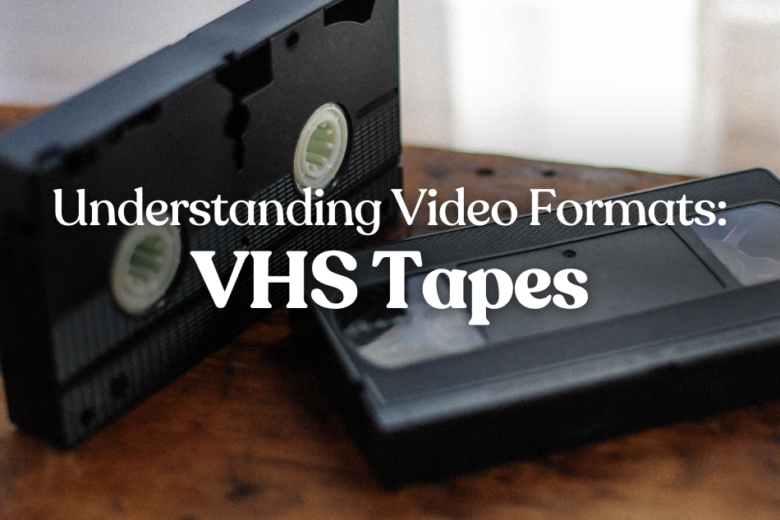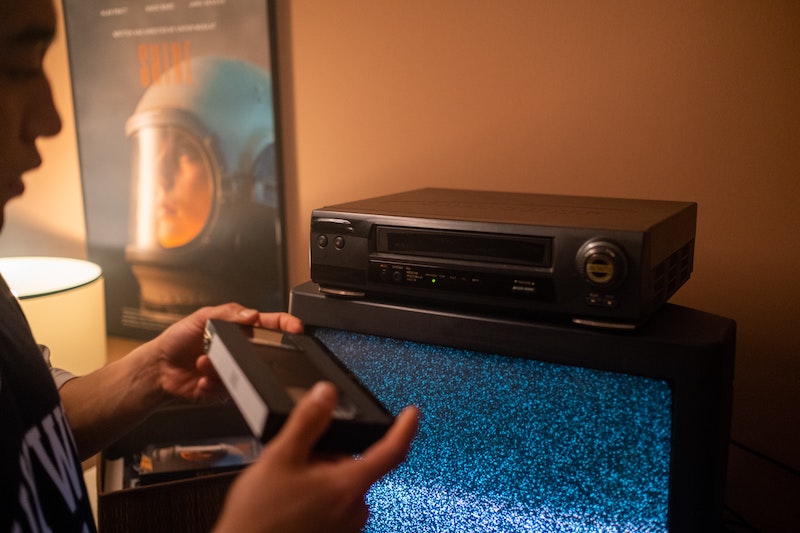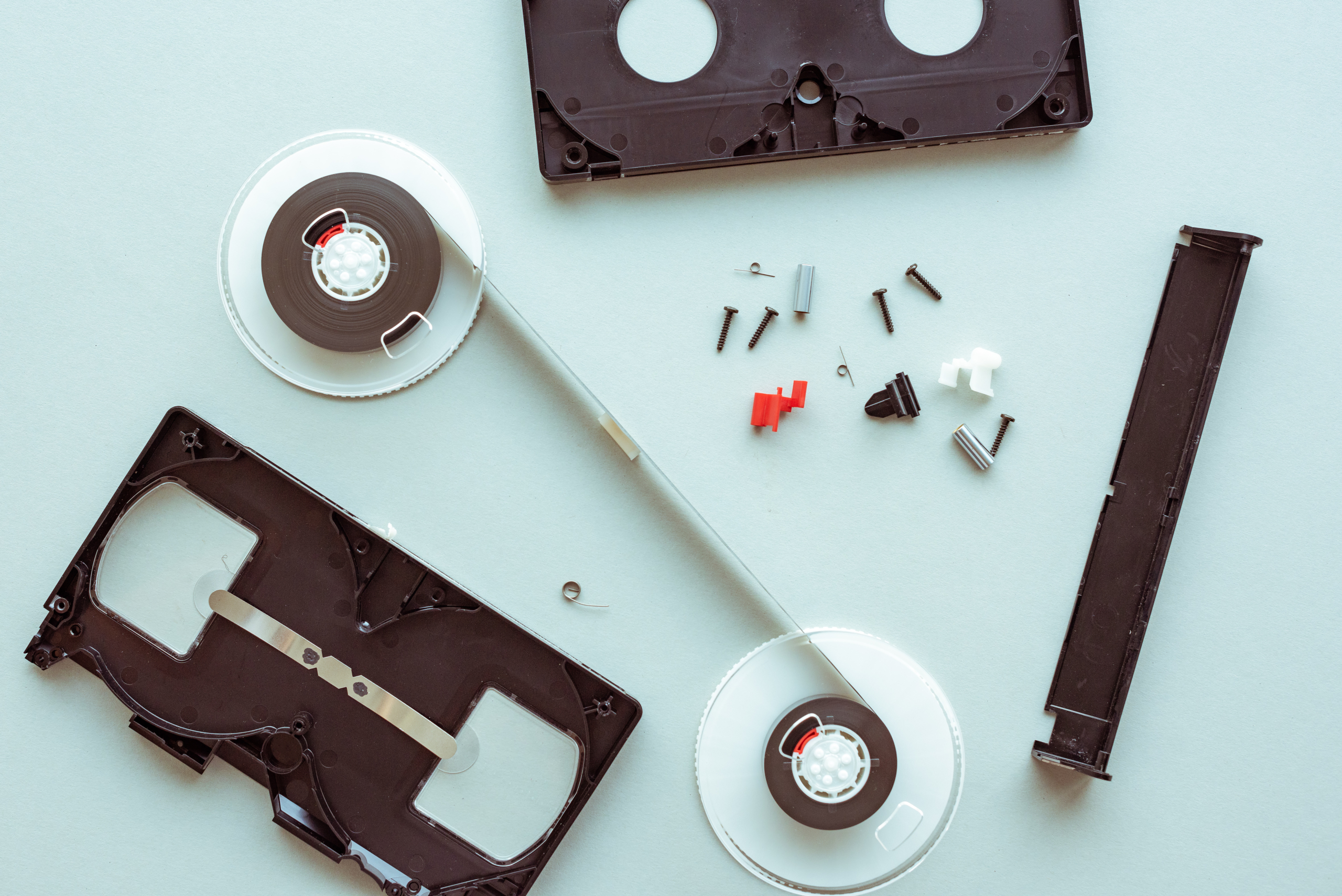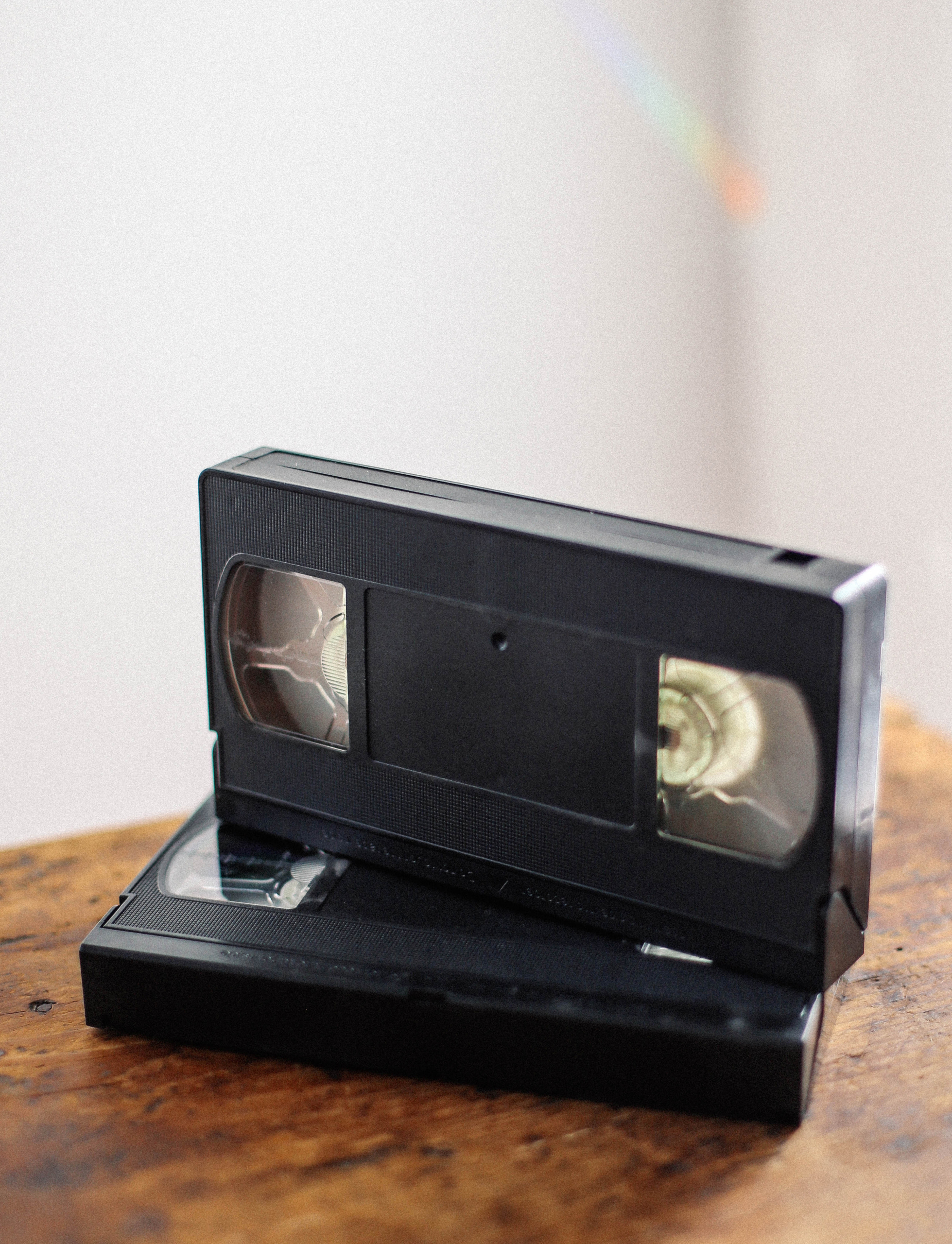VHS tapes became a true household staple in the 80s and 90s. It has been a while, however, since any of us really used a VCR or played a VHS tape, so it’s no surprise if you’ve forgotten most of your VHS knowledge.
In this post, we explore the history of VHS tapes, how they work, and how you can watch them.
WHAT IS A VHS TAPE?
VHS tapes are a type of video storage and playback technology, and the first of their kind to truly reach the status of “household staple.” By the 1990s, most households in the United States, Europe, and Japan had a VCR player to watch movies and TV shows. Many families also had their own camcorders to record family videos onto VHS tapes.
The technology behind VHS tapes is fairly complicated, but to put it simply, magnetic tape coated with iron oxide particles is magnetized to record audio and video signals. To keep the delicate tape safe, it’s encased in the familiar plastic cassette we all recognize.
WHEN WERE VHS TAPES INVENTED?
The VHS format was developed in Japan by JVC in the 1970s. It wasn’t the first videotape format, though. Sony’s Betamax tapes were released a year before and were already widely popular by the time VHS came on the market.
VHS had a much longer running time than Betamax, however, and the competition between the two tape types was fierce. Over time, it became known as the “videotape format war” and it was VHS that ultimately came out on top.
There are a lot of different theories about which tape was better or why the format war ended the way it did, but the truth is it was likely due to many factors. One important weakness of the Betamax tapes was that Sony kept them as a proprietary technology, so only a few companies could manufacture Betamax products. VHS products, on the other hand, were manufactured by hundreds of companies and benefited from strategic marketing and licensing agreements.
WHEN WERE VHS TAPES POPULAR?
VHS tapes were at their most popular during the 80s and 90s, but plenty of people continued to use them well into the 2000s. Even when people started buying new movies on DVD, many continued to watch older films on VHS as they already owned them. This habit wouldn’t die out completely until online streaming became popular and people could watch 90s films and shows on an app rather than busting out the VCR.
In the 70s, the very first film to ever come out on VHS was a Korean film named “The Young Teacher.” The film was released in 1972 and was available on VHS in 1976. Fast forward to 2005 and an action thriller called “A History of Violence” became the last ever movie released on VHS. It starred Viggo Mortensen (from The Lord of the Rings movies) and it was nominated for two Academy Awards.
Nowadays, many VHS hobbyists like to collect vintage VHS tapes—and rare movies can fetch a very high price. Original VHS tapes of Disney’s “Beauty and the Beast” can sell for thousands of dollars.
HOW DO VHS TAPES WORK?
The important part of a VHS tape is—unsurprisingly—the tape. A plastic cassette protects it while it’s not in use, but once inserted into a VCR, the lid opens so the machine can access the tape.
The longest VHS tapes have an astonishing 430 meters (1,410 feet) of tape concealed inside them, which equals around four hours of run time. The tape holds all the information, and the VCR retrieves the recorded signals from it and converts them into audio and video output that you see and hear on your TV.
HOW LONG IS A VHS TAPE?
There are lots of options when it comes to VHS lengths. The run time even varies by region thanks to the different encoding standards used in places like the United States and Europe.
120 minutes, 180 minutes, and 240 minutes were all common tape capacities but the options didn’t stop there. You could also choose to record at different levels of quality: EP (extended play,) LP (long play), and SLP (super long play) options allowed you to record for up to 12 hours. It wouldn’t look or sound as good, but sometimes that wasn’t the priority. Footage like this can still easily be transferred to DVD.
HOW TO WATCH VHS TAPES
If you don’t have a VCR at home anymore, finding a new one could be a challenge. Your best bet is to search for a VCR/DVD combo since those were still being made well into the 2000s. You might also be able to find a TV with a built-in VCR. These were still popular in the early 2000s, too.
If you have any family members or friends who like to keep old things, it’s worth asking them if they still have theirs hiding in the attic. If you find a VCR, keep in mind that you might need an HDMI converter box to connect it to a newer TV.
HOW TO STORE VHS TAPES
If you want to keep your VHS tapes in working condition for as long as possible, it’s important to know how to store them properly. The first key point is to never stack tapes on top of each other. Instead, store them vertically side by side to avoid weight and pressure building up.
Good air circulation and around 30 to 45% humidity are also important to avoid moisture buildup and mold. The best temperature is fairly cool—50 to 60 degrees Fahrenheit.
HOW LONG DO VHS TAPES LAST?
A VHS tape typically lasts between 10 and 25 years, but there are a lot of different factors that contribute to their longevity. Some brands are higher quality than others, for example, and improper storage can greatly decrease lifespan.
A collection of home videos from the 90s will almost definitely be starting to deteriorate by now, and there could easily be damage depending on how they’ve been stored.
WHAT TO DO WITH OLD VHS TAPES
If you don’t need your VHS tapes anymore, disposing of them isn’t as easy as throwing them in the trash. If you just want them gone quickly, the best thing to do is take them to a recycling center. If you’re willing to put in a little more work, you can also try upcycling them (using the tapes to make retro-themed furniture and items), donating them, or selling them.
HOW TO REPAIR VHS TAPES
If you find a tape that won’t play, there are a few things you can try to fix yourself. Here’s a condensed version of our repair guide:
- Open the cassette by removing the five screws on the back of the tape
- Press and hold the white lever to unlock and remove the reels
- Remove the damaged tape sections with scissors
- Use splicing tape (or Scotch tape) to reconnect the tape as neatly as possible
- Put the tape back together
If it doesn’t work, you might need to think about calling in some professionals.
HOW TO CLEAN VHS TAPES
The easiest and safest way to clean VHS tapes is to use an electronic tape cleaner. These could be a little hard to come by now, but if you can get your hands on one, use the instructions or find a walkthrough on YouTube to make sure you’re doing things right.
If you have to resort to manual cleaning, make sure to wear gloves and work carefully. Lift the top flap of the tape casing and pull out 10 to 12 inches of tape. Using a clean microfiber cloth, gently wipe the exposed tape to remove dust and debris.
Don’t use any liquid because this will damage the tape. Once you’re done, spin the reels to pull the tape back into the cassette and repeat the process again with a new section.
HOW TO CONVERT VHS TAPES TO DIGITAL
If you’re feeling adventurous, you can try converting your VHS tapes to DVDs yourself using a VCR and an analog-to-digital converter. If you’re scared of making a mistake or your collection is really large, however, we recommend reaching out to EverPresent.
We take on projects both large and small, with plenty of extra services available. We can organize your entire collection and even pick it up right from your house. Call us today to see how we can help out.





